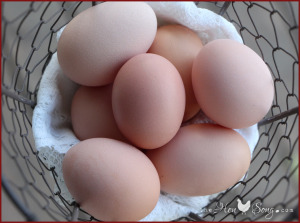With our temps finally dipping into the minus temps, I thought I’d chat a bit about the cold weather here in southcentral Alaska. There has been much talk about when to heat coops, should I let my girls out, how much ventilation does my coop need, etc. The following are my thoughts, so please take them as such. It’s just how I do things, what works best for my situation. Other chicken keepers will have opinions about what works best for them. And, it’s all good info. Take what works for you.
We don’t get it as cold as Fairbanks, but we usually get colder temps than on the Kenai peninsula or in southeast Alaska. Minus temps are not unusual. What has been unusual is that we didn’t get any minus temps in 2014. The times—they are a changin’.
In talking about chickens in cold weather, one thing many folks don’t realize is that most breeds of chickens are better suited for the cold than the heat. I had read somewhere that if a chicken’s internal body temperature reaches 114 she will simply drop dead. Cold, on the other hand, doesn’t affect them that way. Keep in mind, some breeds are better suited for the cold and some for the heat. I only have cold hardy breeds.
Before I talk about my situation, there are a few basics that need to be understood:
- Frostbite is a result of cold + moisture. Think about standing in 20 degree weather when it’s dry. Now picture what it feels like wet. HUGE difference. The areas subject to frostbite are the comb, wattles, ear lobes, feet… basically, any exposed flesh. (Coops without ventilation will have moisture build up inside.)
- Feathers are one of the natural defenses chickens have when it comes to the cold. Ever worn a down jacket? Chickens have beautiful down feathers which they use to fluff up and trap a layer of heated air right next to their skin. A draft will steal this layer of warmth, making draft free areas critical for their well being.
- Hens usually sleep with their heads tucked under a wing, thereby keeping their comb, wattles and ears nice and toasty warm.
- Chickens will roost together for warmth. Each chicken gives off approximately 40 BTUs of warmth (depending on her size).
- Toes are protected when chickens roost on a relatively flat and wide perch, so their toes are covered by their breast feathers. A 2×4 (with the fat 4″ side up) works very well. If you have the 2″ side up, their toes can stick out below their feathers (and possibly get frostbite).
 Acclimate. Allow your chickens time to acclimate to the cold. If they are used to a warm coop when the outside temp. is much colder, they are more likely to come down with respiratory or other illnesses. Nature usually provides a nice adjustment period called autumn. Let your chickens feel the gradual drop in temp. I noticed a lot of downy feathers being grown during autumn.
Acclimate. Allow your chickens time to acclimate to the cold. If they are used to a warm coop when the outside temp. is much colder, they are more likely to come down with respiratory or other illnesses. Nature usually provides a nice adjustment period called autumn. Let your chickens feel the gradual drop in temp. I noticed a lot of downy feathers being grown during autumn.
To heat or not. I don’t heat my coop. That is, I installed a wall-mounted flat panel heater behind the roosts, but have not had to use it, yet. I wanted it in there for the 20 below temps, just in case. My coop is well insulated—walls, ceiling and floor are all insulated between the 2×4 construction with R-13 batting. I don’t use a heat lamp, too much of a fire hazard. I know of a number of coops that have burned down, with the chickens inside. Yeah—not going there. The wall-mounted unit I have is warm to the touch, not hot. Very little fire risk, and I would only use it temporarily, if at all.
Ventilation. This is a biggie! And sometimes a bit hard to understand, at first. Ventilation will help remove the moisture that builds up from chicken breath and their poop. The last thing you want is a coop that is so tightly insulated there is no ventilation. That is a sure recipe for frostbite (and possible respiratory infections). It seems counter-intuitive, but, you have to have open windows no matter how cold it is outside. How much? Enough so the moisture (and dust from feathers, litter, food, etc.) can be moved outside. Yes, you will lose some heat, that’s unavoidable. It’s best to have the open windows higher up, since heat rises. This helps keep your coop air cleaner in the winter, as well reduce frostbite risk. Remember, chickens have an extensive respiratory system and are subject to illness if breathing in dusty air.
Draft free areas. As discussed above, chickens in drafty (or breezy, windy) areas have a much more difficult time keeping themselves warm. It is critical that they have areas where they can get out of the wind. Draft free coops are very important. Having your vents or windows up high reduces the possibility of creating drafts in your coop. Be sure the roosting area, especially, is free of drafts.
 Deep Litter Method. I choose to do the deep litter (composting) method in my coop. I have found it takes quite a bit of time and determination to get just the right balance, so you don’t have ammonia build up, yet actually have it produce heat. I won’t go into all the details here—just too much. Perhaps I’ll blog more about that later. Basically, if you are doing it right, you will actually be generating heat from your litter AND produce yummy compost for your garden. A win-win, if ever there was one! Currently, my coop is 15 degrees warmer inside, even in minus temps. I suspect (hope) that as it continues to cook (compost), it will warm up even more. I know a couple folks who have had incredible results, but it took time to figure out exactly what worked best for their individual situation.
Deep Litter Method. I choose to do the deep litter (composting) method in my coop. I have found it takes quite a bit of time and determination to get just the right balance, so you don’t have ammonia build up, yet actually have it produce heat. I won’t go into all the details here—just too much. Perhaps I’ll blog more about that later. Basically, if you are doing it right, you will actually be generating heat from your litter AND produce yummy compost for your garden. A win-win, if ever there was one! Currently, my coop is 15 degrees warmer inside, even in minus temps. I suspect (hope) that as it continues to cook (compost), it will warm up even more. I know a couple folks who have had incredible results, but it took time to figure out exactly what worked best for their individual situation.
Keeping waterers unfrozen. I built two “cookie tin” heaters for my waterers (see DIY Cookie Tin Waterer on how to make them). I have one larger waterer outside in the run, and a smaller (chick-sized) waterer inside the coop. The inside one is only turned on when necessary and sits by an open window, so as not to create too much extra moisture inside.
Coop size. Your coop size and the number of chickens you house will play a role in moisture build up and how warm it will get inside without heat. Generally, 4 sq. feet of floor space per bird seems to be enough room without worrying about pecking issues (assuming they have access to an outside run). I have that ratio and it works well for my situation. Imagine only having three birds inside an 8’x12′ coop vs. eight birds inside an 8’x4′ coop. Which is going to be warmer just from the heat the chickens give off?
 Breed choice. I prefer cold hardy breeds since I live in a cold climate. I know folks in Alaska who choose to have breeds which require a bit more care in the winter. To each their own. Since I am relatively new to chickens, it made sense to choose a breed which would do well in the cold. I have Plymouth Rocks and Wyandottes, both of which are cold hardy, and doing extremely well in our minus temps today. All of my girls venture out in the snow and ice. None stay in the coop. I’ve always opened the door for the day, giving them the choice to go out or not. They all move around chattering, scratching, pecking… loving life.
Breed choice. I prefer cold hardy breeds since I live in a cold climate. I know folks in Alaska who choose to have breeds which require a bit more care in the winter. To each their own. Since I am relatively new to chickens, it made sense to choose a breed which would do well in the cold. I have Plymouth Rocks and Wyandottes, both of which are cold hardy, and doing extremely well in our minus temps today. All of my girls venture out in the snow and ice. None stay in the coop. I’ve always opened the door for the day, giving them the choice to go out or not. They all move around chattering, scratching, pecking… loving life.
So, I know that was a bit of a ramble, but if you gleaned any info from it then I am just pleased as punch. As chicken keeping is an ever-changing journey of learning, this is also a great reference for me to come back to in years to come, and see if my thoughts are still the same.
Here’s to a beautiful winter, filled with happiness and lots of farm fresh eggs!
 Well, you’re not alone. There’s nothing more frustrating than chipping away at the peel and getting nowhere. Farm fresh eggs won’t peel easily if you boil them. But there is a way… steam, baby, steam!
Well, you’re not alone. There’s nothing more frustrating than chipping away at the peel and getting nowhere. Farm fresh eggs won’t peel easily if you boil them. But there is a way… steam, baby, steam!













